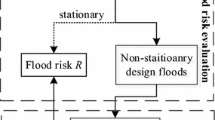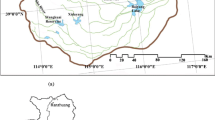Abstract
The construction and the operation of multi-reservoir has severely altered the downstream design flood. This paper quantified the flood frequency modifications caused by multi-reservoir regulation with recorded data and a numerical model composed of peaks-over-threshold (POT) samples and time-trend models. The whole research was carried out in Dongjiang River Basin, Southern China. Results showed that (1) Sampling with the POT method could eliminate fake changes in change detection and prevent the underestimation of the design floods with an exceeding probability over 90% and the overestimation of the design floods with an exceeding probability less than 80%; (2) Multi-reservoir regulation severely reduced design flood when the exceeding probability was greater than 1% and smaller than 95%. The 10-year floods were mitigated the most. However, when the exceeding probability was over 95%, the impact was insignificant; (3) Flood mitigation was positively correlated to the number of reservoirs, but negatively correlated to the distance between the affecting reservoir and the affected station. However, when multiple reservoirs took effect on the design flood in one station, the closest reservoir did not necessarily take the most effect. The results of this research will amplify the theoretical basis for flood protection and the planning of regulation.







Similar content being viewed by others
References
Ayalew Tibebu B, Krajewski Witold F, Ricardo M (2013) Exploring the effect of reservoir storage on peak discharge frequency. J Hydrol Eng 18:1697–1708
Ayalew Tibebu B, Krajewski Witold F, Ricardo M, Wright Daniel B, Small Scott J (2017) Effect of spatially distributed Small dams on flood frequency: insights from the Soap Creek watershed. J Hydrol Eng 22:04017011
Beguería S, Marta A-M, Vicente-Serrano Sergio M, Ignacio L-MJ, Ahmed E-K (2011) Assessing trends in extreme precipitation events intensity and magnitude using non-stationary peaks-over-threshold analysis: a case study in Northeast Spain from 1930 to 2006. Int J Climatol 31:2102–2114
Bezak N, Brilly M, Šraj M (2014) Comparison between the peaks-over-threshold method and the annual maximum method for flood frequency analysis. Hydrol Sci J 59:959–977
Burn DH (1994) Hydrologic effects of climate change in west-Central Canada. J Hydrol 160:53–70
Chen Y (2018) Distributed hydrological models. Springer Berlin Heidelberg, Berlin
Cunnane C (1973) A particular comparison of annual maxima and partial duration series methods of flood frequency prediction. J Hydrol 18:257–271
Davison AC, Smith RL (1990) Models for Exceedances over high thresholds. J R Stat Soc Ser B Methodol 52(3):393–425. https://doi.org/10.1111/j.2517-6161.1990.tb01796.x
Debele SE, Strupczewski WG, Bogdanowicz E (2017) A comparison of three approaches to non-stationary flood frequency analysis. Acta Geophys 65:863–883
Ding J, Yuan J, Lan F, Qi L, Qiuzhi P, Muyi K (2015) Impacts of land use on surface water quality in a Subtropical River basin: a case study of the Dongjiang River basin, Southeastern China. Water 7:4427–4445
Duan W, Guo S, Wang J, Dedi L (2016) Impact of cascaded reservoirs group on flow regime in the middle and lower reaches of the Yangtze River. Water 8:218
Gautier E, Dépret T, Costard F, Virmoux C, Fedorov A, Grancher D, Konstantinov P, Brunstein D (2017) Going with the flow : hydrologic response of middle Lena River (Siberia) to the climate variability and change. J Hydrol 557:475–488
Gu W, Shao D, Tan X et al (2017) Simulation and optimization of multi-reservoir operation in Inter-Basin water transfer system. Water Resour Manag 31:3401. https://doi.org/10.1007/s11269-017-1675-9
He X, Yoshihide W, Niko W, Justin S (2017) Intensification of hydrological drought in California by human water management. Geophys Res Lett 44:1777–1785
Hoggan Daniel H (1997) Computer-assisted flood plain hydrology and hydraulics. McGraw-Hill, New York
Hosking JRM, Wallis JR (1997) Regional frequency analysis: an approach based on L-moments. Cambridge University Press, Cambridge
Hu Y, Liang Z, Chen X, Liu Y et al (2017) Estimation of design flood using EWT and ENE metrics and uncertainty analysis under non-stationary conditions. Stoch Env Res Risk A 31(10):2617–2626
Kite GW (1988) Frequency and risk analysis in hydrology. Water Resources Publication, Fort Collins, p 224
Lee J, Jun-Haeng H, Lee J, Nam K (2017) Assessment of flood frequency alteration by dam construction via SWAT simulation. Water 9:264
Liang EY, Chan FKS, Scheffran J (2018) Climate change, water management and stakeholder analysis in the Dongjiang River basin in South China. Int J Water Resour Dev 34(2):166–191. https://doi.org/10.1080/07900627.2016.1264294
Liu X, Guo S, Pan L, Fuqiang G (2009) Study on the optimal operating rules for cascade hydropower stations based on output allocation model. J Hydroelectr Eng 28(3):26–31 (in Chinese)
Liu D, Xiaohong C, Yanqing L, Zhanghua L (2010) Impacts of climate change and human activities on surface runoff in the Dongjiang River basin of China. Hydrol Process 24:1487–1495
Liu Z, Guo S, Guo J, Pan L (2016) The impact of three gorges reservoir refill operation on water levels in Poyang Lake, China. Stoch Env Res Risk A 31:879–891
Maingi JK, Marsh Stuart E (2002) Quantifying hydrologic impacts following dam construction along the Tana River, Kenya. J Arid Environ 50:53–79
Martins ES, Stedinger JR (2001) Generalized maximum likelihood Pareto-Poisson estimators for partial duration series. Water Resour Res 37:2551–2557
Mei X, Van Gelder PHAJM, Zhijun D, Zhenghong T (2016) Impact of dams on flood occurrence of selected rivers in the United States. Front Earth Sci 11:268–282
Meng J, Li L, Zhenchun H, Wang J, Quanxi S (2014) Suitability of TRMM satellite rainfall in driving a distributed hydrological model in the source region of Yellow River. J Hydrol 509:320–332
Michelle H, Upmanu L, Maura A, Naresh D, Han KH, Indrani P, David R, David W (2018) The future role of dams in the United States of America. Reviews of Geophysics: Commentaries on Hydrology and Earth Surface, 982-998. https://doi.org/10.1002/2016WR019905
Pall P, Tolu A, Stone Dáithí A, Stott Peter A, Toru N, Hilberts Arno GJ, Dag L, Allen Myles R (2011) Anthropogenic greenhouse gas contribution to flood risk in England and Wales in autumn 2000. Nature 470:382
Razmi A, Golian S, Zahmatkesh Z (2017) Non-stationary frequency analysis of extreme water level: application of annual maximum series and peak-over threshold approaches. Water Resour Manag 31:2065. https://doi.org/10.1007/s11269-017-1619-4
Richter BD, Baumgartner Jeffrey V, Jennifer P, Braun David P (1996) A method for assessing hydrologic alteration within ecosystems. Conserv Biol 10:1163–1174
Risser MD, Wehner MF (2017) Attributable human-induced changes in the likelihood and magnitude of the observed extreme precipitation during hurricane Harvey. Geophys Res Lett 44:12457–12464
Silva AT, Portela MM, Naghettini M, Fernandes W (2017) A Bayesian peaks-over-threshold analysis of floods in the Itajaí-açu River under stationarity and nonstationarity. Stoch Env Res Risk A 31(1):185–204
Silvestro F, Gabellani S, Rudari R, Delogu F, Laiolo P, Boni G (2015) Uncertainty reduction and parameters estimation of a~distributed hydrological model with ground and remote sensing data. Hydrol Earth Syst Sci 11:1727–1751
Song W, Yunzhong J, Xiaohui L, Wang H, Dongcai S (2015) Annual runoff and flood regime trend analysis and the relation with reservoirs in the Sanchahe River basin, China. u 380-381:197–206
Sugahara S, Da Rocha RP, Silveira R (2010) Non-stationary frequency analysis of extreme daily rainfall in Sao Paulo, Brazil. Int J Climatol 29:1339–1349
Tu X, Singh VP, Chen X et al (2015) Intra-annual distribution of Streamflow and individual impacts of climate change and human activities in the Dongijang River basin, China. Water Resour Manag 29:2677. https://doi.org/10.1007/s11269-015-0963-5
Vicente-Serrano SM, Zabalza-Martínez J, Borràs G, López-Moreno JI, Pla E, Pascual D, Savé R, Biel C, Funes I, Azorin-Molina C, Sanchez-Lorenzo A, Martín-Hernández N, Peña-Gallardo M, Alonso-González E, Tomas-Burguera M, El Kenawy A (2017) Extreme hydrological events and the influence of reservoirs in a highly regulated river basin of northeastern Spain. J Hydrol Regional Stud 12:13–32. https://doi.org/10.1016/j.ejrh.2017.01.004
Villarini G, Smith JA, Serinaldi F, Bales J, Bates PD, Krajewski WF (2009) Flood frequency analysis for nonstationary annual peak records in an urban drainage basin. Adv Water Resour 32:1255–1266
Wan X, Hua L, Yang S et al (2018) Evaluating the impacts of a large-scale multi-reservoir system on flooding: case of the Huai River in China. Water Resour Manag 32:1013. https://doi.org/10.1007/s11269-017-1852-x
Wang Z (2007) Effects of climatic change and LUCC on hydrological system in the Dongjiang River basin, South China. Dissertation, Sun Yat-sen University
Wang W., Chen X., Shi P., Van Gelders, PHAJM (2008) Detecting changes in extreme precipitation and extreme streamflow in the Dongjiang River Basin in southern China. Hydrol Earth Syst Sci 12 (1), 207-221 ⟨hal-00305129⟩
Wu J, Zhiyong L, Huaxia Y, Xiaohong C, Xingwei C, Zheng Y, He Y (2018) Impacts of reservoir operations on multi-scale correlations between hydrological drought and meteorological drought. J Hydrol 563:726–736
Xiong L, Du T, Xu CY et al (2015) Non-stationary annual maximum flood frequency analysis using the norming constants method to consider non-Stationarity in the annual daily flow series. Water Resour Manag 29:3615. https://doi.org/10.1007/s11269-015-1019-6
Ye C, Chen X, Zhang J, Zhang L, Zhu A (2014) Comparative study on non-stationary flood frequency analysis in different backgrounds of changing environment. J Hydroelect Eng 33:1–9+18
Zhang Q, Mingzhong X, Chun-Ling L, Singh Vijay P (2014) Reservoir-induced hydrological alterations and environmental flow variation in the East River, the Pearl River basin, China. Stoch Env Res Risk A 28:2119–2131
Zhao G, Gao H, Naz Bibi S, Chieh KS, Nathalie V (2016) Integrating a reservoir regulation scheme into a spatially distributed hydrological model. Adv Water Resour 98:16–31
Zhong Y, Guo S, Zhangjun L, Wang Y, Jiabo Y (2017) Quantifying differences between reservoir inflows and dam site floods using frequency and risk analysis methods. Stoch Env Res Risk A 32:419–433
Zhou T, Wu J, Shaolin P (2012a) Assessing the effects of landscape pattern on river water quality at multiple scales: a case study of the Dongjiang River watershed, China. Ecol Indic 23:166–175
Zhou Y, Qiang Z, Kun L, Xiaohong C (2012b) Hydrological effects of water reservoirs on hydrological processes in the East River (China) basin: complexity evaluations based on the multi-scale entropy analysis. Hydrol Process 26:3253–3262
Acknowledgements
The research is financially supported by Acknowledgement: The research is financially supported by National Key R&D Program of China (2017YFC0405900), National Natural Science Foundation of China (Grant No. 91547202, 51861125203, 51479216), the Chinese Academy of Engineering Consulting Project (2015-ZD-07-04-03), the Project for Creative Research from Guangdong Water Resources Department (Grant No. 2016-07, 2016-01), Research program of Guangzhou Water Authority (2017).
Author information
Authors and Affiliations
Corresponding author
Ethics declarations
Conflict of Interest
The authors declare that they have no conflict of interest.
Additional information
Publisher’s Note
Springer Nature remains neutral with regard to jurisdictional claims in published maps and institutional affiliations.
Rights and permissions
About this article
Cite this article
Tang, Yh., Wu, Jf., Li, Py. et al. Quantifying Flood Frequency Modification Caused by Multi-Reservoir Regulation. Water Resour Manage 33, 4451–4470 (2019). https://doi.org/10.1007/s11269-019-02374-w
Received:
Accepted:
Published:
Issue Date:
DOI: https://doi.org/10.1007/s11269-019-02374-w




